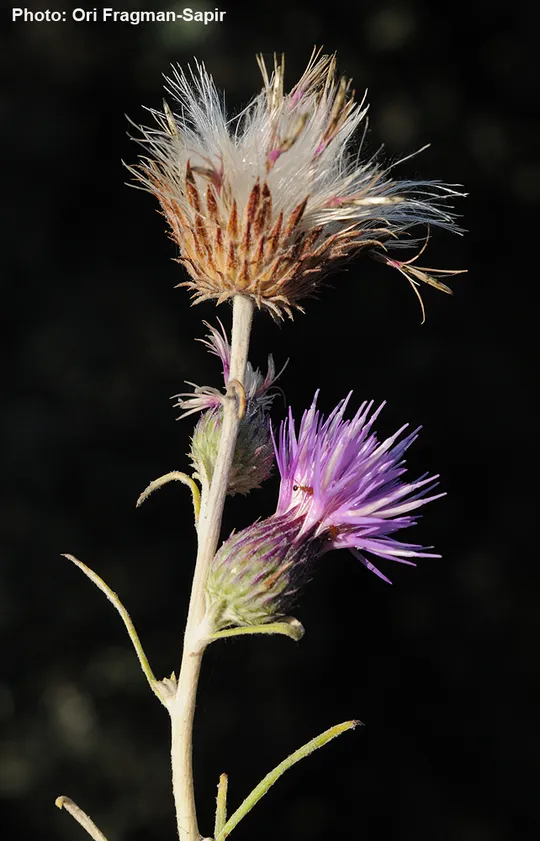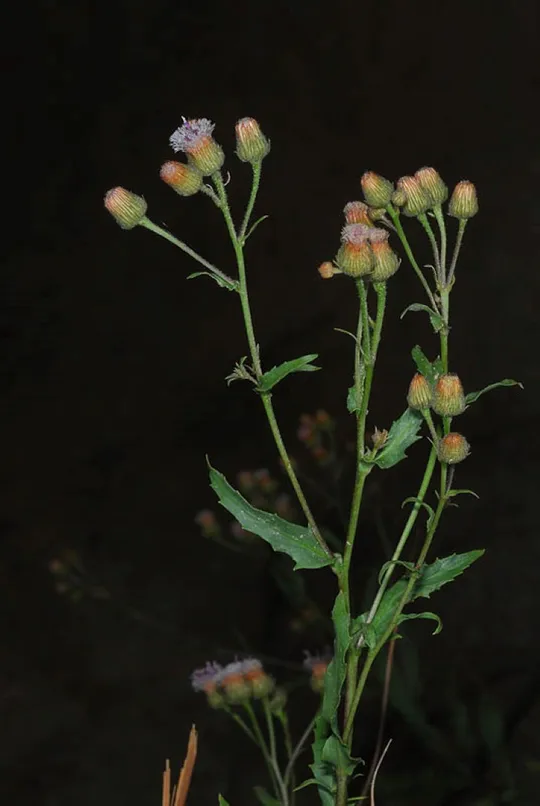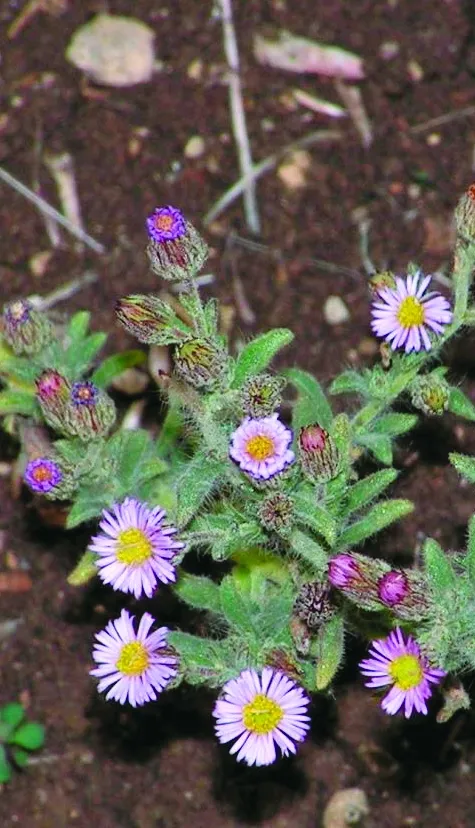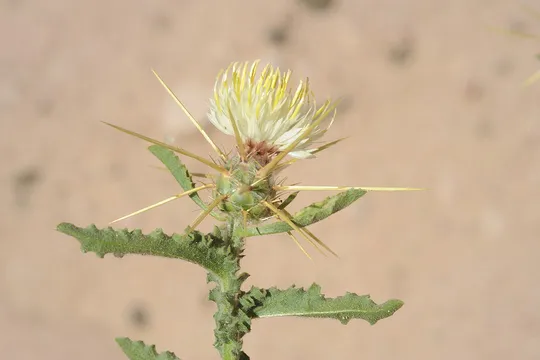Sea Ambrosia, Sea Ragweed
Ambrosia maritima
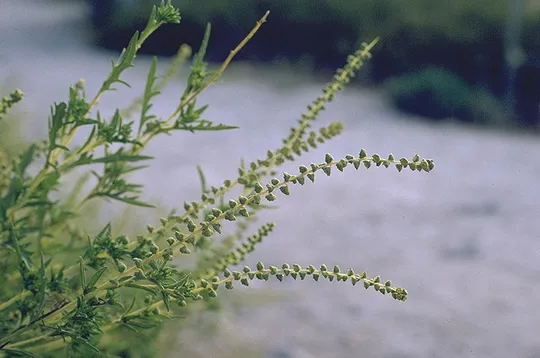
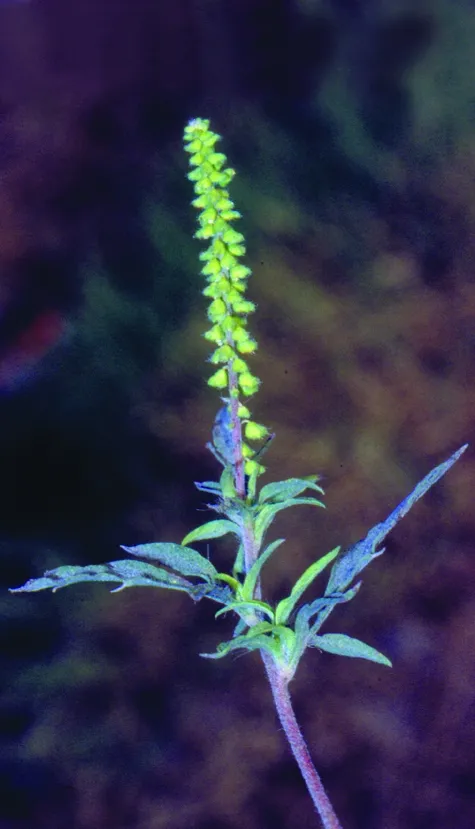
Ambrosia maritima is an annual or perennial strongly aromatic herb up to
1 m tall, with dissected, silvery leaves. The inconspicuous flowers are
wind-pollinated. The male and female flowering heads are separate. The
male heads are arranged in terminal spikes, each with 10-20 tiny,
greenish flowers; the female heads are arranged individually or in
groups in the leaf axils. Each female flowering head has a single
flower; female flowers have no corolla and are enveloped only by the
head's bracts. The stamen protrudes over the male flowering head and
splits in two. Seeds are about 5 mm and covered in short bristles that
become spiny when dry. A. maritima blooms in May-October, at which time
the plants produce large amounts of pollen carried by the wind. The
achenes are not tufted.
Extract from the leaves of
Ambrosia maritima is used to add fragrance to liquors. In Egyptian folk
medicine the extract was used to treat diabetes, and in Egypt today, attempts
are being made to isolate anti-diabetic chemicals from it. The plant’s pollen
kills snails, and various laboratories are studying its potential as a biological
insecticide. The pollen of some Ambrosia species are known allergens and
cause hay fever. The Flora Palaestina however, notes that Ambrosia
pollen is not allergenic.
Ambrosia maritima once grew in five regions in Israel
along the coastal plain. A single observation in 1984 at the Hula Valley indicates
the random character of the species’ distribution. In the Acre Valley, the A.
maritima grows on the seashore, but has not been found there since the
1970s. It was found twice in the Acre Valley as a ruderal species. On the
Carmel Coast, there are five locations along the coastline and at the edges of fishponds
at Ma’agan Mikhael. The finest population in Israel is found in the Dor-HaBonim
Beach Reserve, growing on sand and calcareous sandstone, where it is the
dominant species together with Tamarix nilotica and Phyla nodiflora.
In the Sharon, there were once several populations, but all the plants
collected in the Alexander Stream and Hadera area during the past 15 years are
various naturalized Ambrosia species that differ from Ambrosia maritima.
It was recorded in four locations in southern coastal regions since the 1930s (Gaza,
Tel Aviv, Bne Brak) which are all extinct since the 1970s. Avinoam Danin
collected the species in the Yamit sands in northern Sinai in 1981.
Its primary habitat is the
seashore and coastal salt marshes. Its secondary habitat is roadsides and
ruderal areas, mostly near the shore. On the coastal plain, it once grew on
sand and hamra-sand.
The genus Ambrosia
includes 43 species, which are found all over the world. Its center of
speciation and richest diversity is on the American continent. The genus
includes wind-pollinated small shrubs and annual species. It is similar morphologically
and ecologically to the genus Artemisia (both are pollinated by
wind and dominate in deserts, coastlines and ruderal areas), but it developed independently
(convergent evolution), from a different group in the Compositae family. During
the past 30 years, a number of North American alien species reached Israel and
they are spreading in various sites along the coastal plain. Plants that were
collected in the Alexander and Taninim streams and the Hadera West train
station were mistakenly identified as Ambrosia maritima. Experts later
identified them as alien North American Ambrosia species: A.
confertifolia, A. tenuifolia, A. trifida and A. aretemisiifolia.
·
Development
of the coastal plain led to the extinction of Ambrosia maritima populations that grew along the Mediterranean coast.
Its coastal habitat is severely threatened.
·
A. maritima suffers from extensive fragmentation; there are stable
populations on the seashores and random populations in ruderal areas.
·
In
most of the populations, the number of plants is small. The species comes and
appears every so often in different locations. There are two large stable
population in the HaBonim coastal salt marshes and at the Alexander Stream.
·
Ambrosia maritima is a shore plant, which grows on the shores of the
Mediterranean Sea but can occasionally and unpredictably be found inland, on
roadsides or on rocks (in Turkey), and is common on the Mediterranean coast of
Egypt. It is not globally endangered.
·
It
is protected in the Dor-Habonim Nature Reserve.
Large areas of the
species’ sandy beach habitat should be protected from intensive human activity
and all-terrain vehicle traffic.
On sandy beaches around
the Mediterranean Sea. The species was described from Italy and central Turkey,
where it also grows on sandy beaches and in ruderal areas. It has also been
collected on rocks.
The number of locations
in Israel in which Ambrosia maritima is found has drastically decreased since
the 1930-40s. Despite the fact that it will also grow in disturbed habitats most
of the specimens that have been found in recent years belong to alien Ambrosia
species. The decrease of A. maritima in its primary habitat resulted in
its decrease in disturbed habitats as well. Only a comprehensive study will clarify
whether the alien Ambrosia species are displacing Ambrosia maritima from
Israel.
Abou Basha, L.M., el Sayad, M.H., Allam, A.F. and Osman, M.Mm 1994. The effect of Ambrosia maritima (Damsissa) on the viability of Lymnaea cailliaudi; an experimental study. J Egypt Soc Parasitol. 24(3): 513-7.
Current Occupancy Map
| 1000 squre meter pixel | 5000 squre meter pixel | 10000 squre meter pixel | |
|---|---|---|---|
| number of observations | 0 | 0 | 0 |
| in total pixels | 0 | 0 | 0 |
| Family | Asteraceae |
| Classification | On the endangered species list |
| Ecosystem | Coastal area |
| Chorotype | Mediterranean |
| Conservation Site | Dor – HaBonim Beach nature Reserve |
| Rarity |
1
2
6
|
|---|---|
| Vulnerability |
0
4
4
|
| Attractiveness |
0
0
4
|
| Endemism |
0
0
4
|
| Red number |
1
3.2
10
|
| Peripherality | 0 |
| IUCN category | DD EW EX LC CR EN VU NT |
| Threat Definition according to the red book | Extinct |
 Based on:
Based on:
